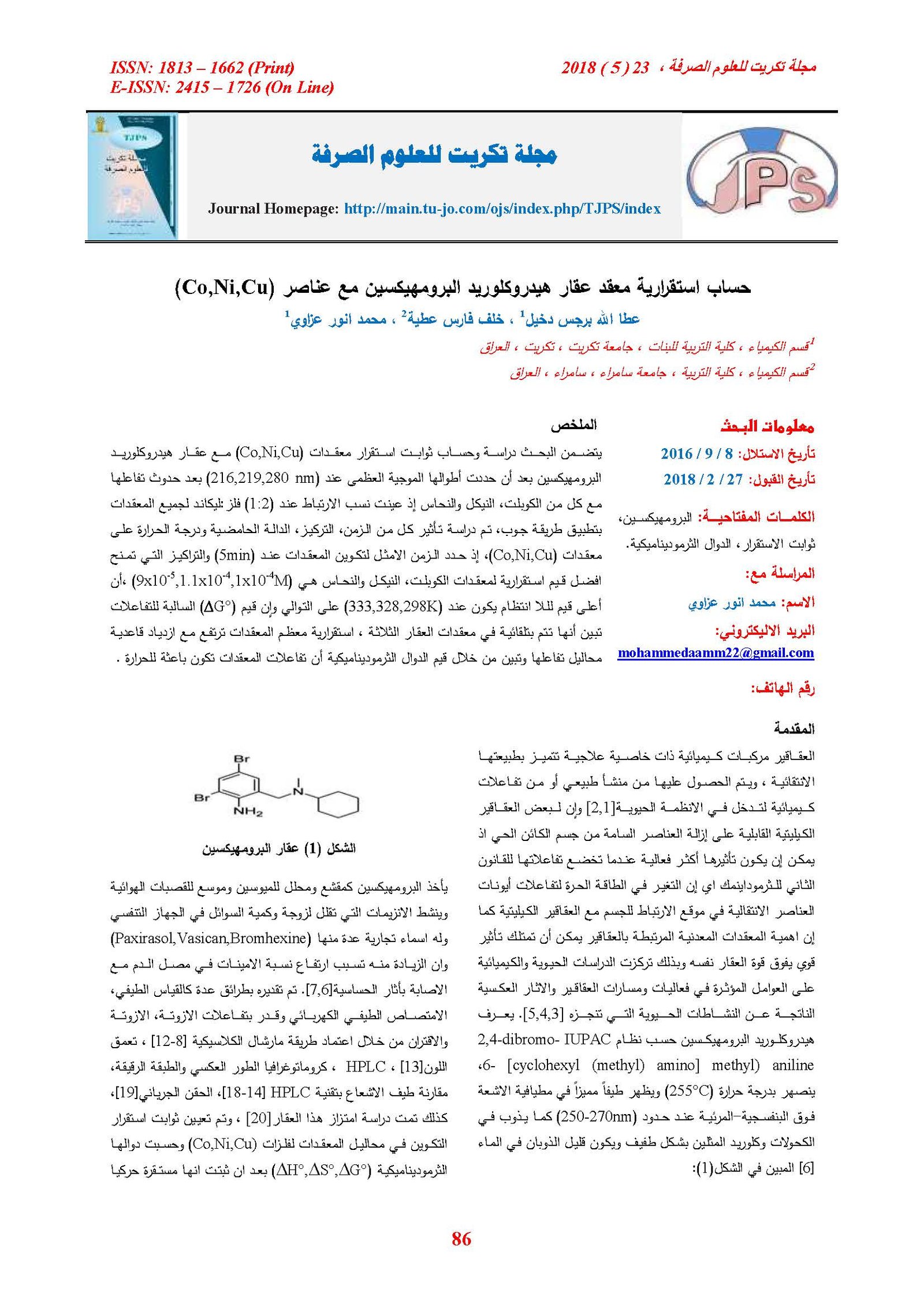Calculation Constants of stability for Complex Durg Bromhexine Hydrochloride With elements (Co,Ni,Cu)
Main Article Content
Abstract
The research included studying and Calculation Constants of stability in the complexes: (Co,Ni,Cu) with Bromhexine Hydrochloride after they were limited their greatest length wave at (216,280,219nm) for each of the three element respectively, as they designed the ratios of their linking at (2:1) ligand : metal for all complexes by applicating Job method. The research was calculated the impact of the time , the concentration and temperature on the complexes (Co,Ni,Cu) and the ideal time was (5min) and the concentrations that gave the best values of stability for the complexes: (9x10-5,1.1x10-4,1x10-4M) as well as found that the increase in irregularity of their systems occurred the highest values at (333,328,298K) respectively. The negative value of (G°) for the reaction showed they were spontaneous once respectively and the stability of all complexes. Through the value of thermodynamical function, it showed that the reactions forming the complexes are exothermal.
Article Details

This work is licensed under a Creative Commons Attribution 4.0 International License.
Tikrit Journal of Pure Science is licensed under the Creative Commons Attribution 4.0 International License, which allows users to copy, create extracts, abstracts, and new works from the article, alter and revise the article, and make commercial use of the article (including reuse and/or resale of the article by commercial entities), provided the user gives appropriate credit (with a link to the formal publication through the relevant DOI), provides a link to the license, indicates if changes were made, and the licensor is not represented as endorsing the use made of the work. The authors hold the copyright for their published work on the Tikrit J. Pure Sci. website, while Tikrit J. Pure Sci. is responsible for appreciate citation of their work, which is released under CC-BY-4.0, enabling the unrestricted use, distribution, and reproduction of an article in any medium, provided that the original work is properly cited.
References
1. Nagano, K.; Tsukara H. and Tamura. "Synthesis of Some Transition Metal Chelates of Furfurylidene Benzoyl Hydrazones as Potential Fungicides".Z. Chem. Pharm., p.12, (1964).
2. Lomis, T. "Essentials of Toxicology". Lea and Febiger, Philadelphia,: p.7, (1978).
3. Aibert, A. "Selective Toxicity and Related Topics".4th Ed ., Board and Nobel, New York, p. 95. (1980).
4. Ribone, M.; Pagani, A. and Olivier, A., "Determination of the minor component bromhexine in cotrimoxazole-containing tablets by absorption spectrophotometry and partial least-squares (PLS-1)multivariate calibration”, J. Pharm. Biomed. Anal., 23: 591-595,(2000).
5. Murali Mohan Rao, S.; Nageswara Rao, I.; Rama Subba Reddy, T. and Sastry, C., “Assay of bromhexine hydrochloride in pharmaceutical formulations by extraction spectrophotometry”, Indian Journal of Chemical Technology, 12: 170-174, (2005).
6. The Stationery Office on behalf of the Medicines and Healthcare products Regulatory Agency (MHRA). British Pharmacopoeia on CD-Rom. 6th Ed ., London ,(2010).
7. Dave, N.; Mashru, R. and Thakkar, A., “Simultaneous determination of salbutamol sulphate, bromhexine hydrochloride and etofylline in pharmaceutical formulations with the use of four rapid derivative spectrophotometric methods”, Anal Chim Acta., 1: 113-120, (2007).
8. Dias, A.; Santos, J.; Lima, J. and Zagatto, E., “Multi-pumping flow system for spectrophotometric determination of bromhexine”, Anal. Chim. Acta., 499 : 107-113, (2003).
9. Chu, K. and Tin, K., “Analysis of Antihistamines in Cough Syrup”, Anal. Lett., 31: 1879-1890, (1998).
10. Susmitha, K; Thirumalachary, M. and Venkateshwarlu, G., “Spectrophotometric determination of bromhexine HCl in pure and pharmaceutical forms”, ISRN Analytical Chemistry., 7:1-7 (2013).
11. Rajan, V.“Simultaneous UV-spectrophotometric estimation of bromhexine hydrochloride and salbutamol sulphate by third order derivative Method in combined pharmaceutical dosage form”, Journal of
Chemical and Pharmaceutical Research,8(3):289-294,(2016).
12. Santoro, M.; dos Santos, M. and Maqalhaes, J., “Spectrophotometric determination of bromhexine hydrochloride in pharmaceutical preparations”. J Assoc Off Anal Chem., 67 :532-540, (1984).
13. Vijaya, G. ;Venu, G.; Mounika, V.; Satyavathi, S. and Lavanya, C., “Simple colorimetric assay for microgram determination of bromhexine hydrochloride with mbth and 2, 2’ bipyridyl”, IJPSR., 1 (2) : 90-94,(2010).
14. Dave, H. N.; Mashru, R. C. and A. K. Patel, “Thin layer chromatodraphy method for the determination of ternary mixture containing salbutamol sulphate, bromhexine hydrochloride and Etofylline,” Journal of Pharmaceutical Sciences and Research, 2 , 3: 143–148, (2010).
15. Shaikh, K.; Patil, S. and Devkhile, A., “Development and validation of a reversed-phase HPLC method for simultaneous estimation of ambroxol hydrochloride and azithromycin in tablet dosage form”, J. Pharm. Biomed. Anal., 48: 1481-1484, (2008).
16. Packert, B; Gammelgaard, B; Honore, S. and Vanggaard, J., “HPLC-ICP-MS compared with radiochemical detection for metabolite profiling of 3H-bromohexine in rat urine and faeces”, J. Anal. At. Spectrom., 20 : 204-209, (2005).
17. Senthilraja, M. and Giriraj, P “Reverse phase HPLC method for the simultaneous estimation of terbutanile sulphate, bromhexine hcl and guaifenesin in cough syrup”, Asian J Pharm Clin Res, 4, 2:13-15(2011).
18. Pai, P.N.S; Rao, G. K; Murthy, M. S; Agarwal, A and Puranik, S., “Simultaneous determination of salbutamol sulphate and bromhexine hydrochloride in tablets by reverse phase liquid chromatography”, Ind. J. pharma. sci., 71: 53-55, (2009).
19. Abdel-Ghani, N.; Issa, M. and Ahmed, M., “Potentiometric flow injection analysis of bromhexine hydrochloride and its pharmaceutical preparation using conventional and coated wire ionselective electrodes”, Scientia Pharmaceutica, 74: 121-135, (2006).
20. Qtaitat, M.; Zughul, B. and Badwan, A. “bromhexine hydrochloride adsorption by some solid
excipients used in the formulation of tablets”, Drug Development and Industrial Pharmacy, 1 4 , 4 : 415-429 (1988).
21. Hamud, W., “Synthesis ,Characterization and Kinetic Study of Metal Complexes with New Acyclic Ligand N2O2”. Diyala Journal For Pure Scinces, 9 , 1: p.63 ,(2013).
23. Sawyer, D.; Heinemann, W. and Beebe, J., “Chemistry Experiments for instrumental method”, 3red Ed., John Wiley and Sons, N. York. 1984: p.330.
24. Cotton F. and Wilkinson, G.,“Principle of Inorganic”, Chem.5th ed., (1981).
